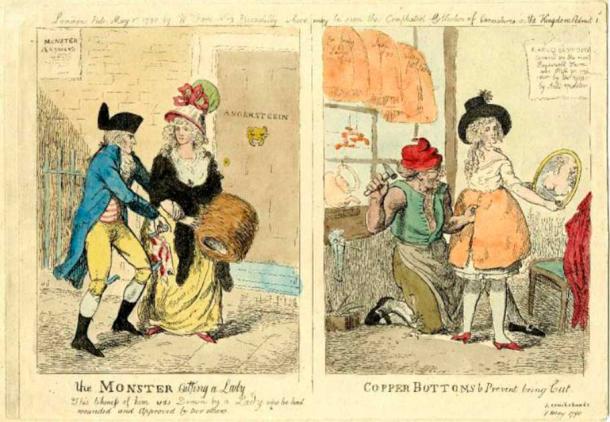While the infamous Jack the Ripper and his legendary killing spree in the 19th century is the stuff of legends, few have heard of another forgotten assailant who terrorized the streets of London just a century before. Nevertheless, the actions of the so-called Monster of London sparked hysteria on the streets of London and even inspired a bizarre trend in bottom guards.
Active between 1788 and 1790, the villain attacked unaccompanied, fashionable and well-to-do women by stabbing them on their thighs, buttocks, breasts or face with a sharp object, such as a rapier or knife. Termed ‘piquerism’, a sexually motivated urge to penetrate someone’s skin with a sharp object, the perpetrators modus operandi morphed over time. At one stage he began hiding his weapon within a bunch of flowers, or nosegay, stabbing his victim in the nose as she leaned in to smell.
The whole sordid affair was brought to light by Jan Bondeson, whose chance discovery of a poster within the British Library set him off on a journey which culminated in his publication of the 2002 book The London Monster: A Sanguinary Tale . The first attack on record was against Maria Smyth, who had a nervous breakdown after being stabbed in the breast and thigh by the crazed Monster of London. By 1790, more than 50 people had been attacked, reporting a pattern of behavior which included loitering, stalking and stabbing, often accompanied by verbal abuse.
The Monster of London ended up attaining celebrity status, inspiring one well-meaning London broker, John Julius Angerstein, to offer a £100 reward for his capture on posters pasted all over the city. Chaos ensued, inspiring possible copycats and a series of gung-ho vigilante monster hunters. One group of men even founded the No Monster Club, wearing badges on their lapels. A maelstrom of false accusations ensued, fueled by media sensationalism and numerous contemporary caricatures.

Isaac Cruikshank print from 1790 depicting the Monster of London on the left, and a lady getting a copper petticoat made at a brazier’s shop on the right. (British Museum / CC BY-NC-SA 4.0 )
In the hope of shielding their sensitive buttocks, women started to wear a series of bizarre and ingenious protective undergarments, including cork rumps, copper petticoats and even porridge pots under their skirts. While this sounds very strange indeed, it was actually a thing during the 18th century. In the 1770s and 1780s women even entertained the habit of a wearing false rumps. Cork was sewn into pockets to enhance their posteriors and make their waist seem slimmer.
Faced with a wave of panic, a Welsh man called Rhynwick Williams was accused, found guilty and sent to prison for six years, to an audience of jeering spectators. Bondeson has theorized that he was merely a scapegoat to deflect the lack of an adequate police force in the case of the Monster of London . Some have even argued that there was never a monster to begin with, but that the story was just a product of mass hysteria , joining the ranks of well-known cases such as of the Salem Witch Trials .
Top image: The monster of London going to take his afternoons luncheon, in an etching by James Gillray. Source: Public domain
By Cecilia Bogaard
 RSS Feed
RSS Feed















 November 14th, 2022
November 14th, 2022  Awake Goy
Awake Goy  Posted in
Posted in  Tags:
Tags: 













